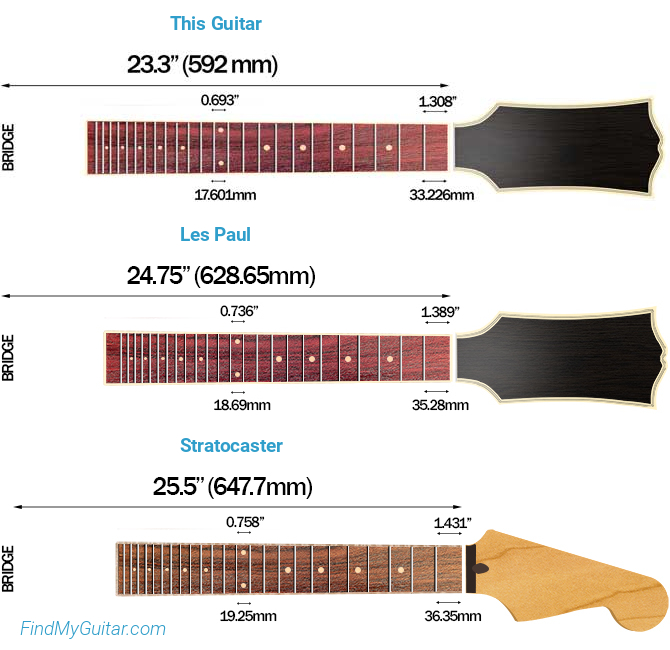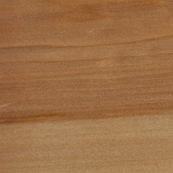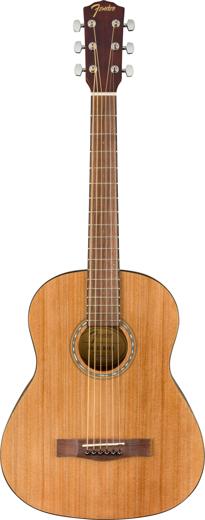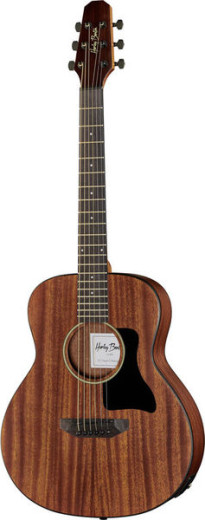Fender FA-15 3/4 Steel Review & Prices
- From Fender's 2020 Fender Alternative series
- Made in China
- 6 strings
- 23.3"'' scale
- 11.81" Fretboard Radius
- Laminated Agathis top
- Laminated Sapele back
- Laminated Sapele sides
- Nato neck
- Walnut fretboard
- Bridge pickup: (/)
- Walnut bridge
- Acoustic C Shape Set neck
- 18 Vintage frets
- Die-Cast tuners
- Compare Specs >
Our Scores and Tone Evaluation
- Heavy Metal
- Hard Rock
- Jazz
- Blues
- Funk
- Country
Fender FA-15 3/4 Steel
- Synthetic Bone Nut
- Synthetic Bone Saddle
- Cheap Fret Wire (NS)
- No Locking Tuners
- Made in China
- No Expensive Woods
- No Top Brand Pickups
- No Electronics
- Laminated Top Wood
- Laminated Side Wood
- Laminated Back Wood
- No Compound Radius Fretboard
- No 21:1 Tuner Ratio
- No Strap Lock
Price Overview
Its average competitor's price is $430, which means that the Fender FA-15 3/4 Steel is around 65% cheaper than the competition. This takes into account all instruments of the same category in our database with 6 strings and Fixed bridge that are made in China.
These are affiliate links. We may earn a fee if you purchase after clicking. These prices are prone to error. Make sure you're buying the right product after clicking on a link from our site. We are not liable if you buy the wrong product after following these links. As an Amazon Associate site we earn from qualifying purchases.
Videos




Your feedback
Not all instruments are created equally. That's why it's important to have different opinions. Here's what our users who have played this instrument say. If you've played it before, help others by voting below!
Weight
VoteTuning stability
VoteNeck speed (thickness)
VoteNeck access to high frets
VoteNeck profile shape
VoteFret edges
VoteIs it Easy to Play?
The Fender FA-15 3/4 Steel meets 4 out of our 8 criteria items for beginner friendliness, which means that it's not bad for beginners, but it could be better. This takes into account the type of frets, scale length, nut width, bridge type, fretboard radius, and neck profile to determine the easiest combination for new players to get used to.
New Player Friendliness
Fender FA-15 3/4 Steel- Comfortable shape
- Easy-to-use bridge
- Short scale
- Comfortable neck
- Comfortable fretboard
- Tall frets
- Narrow nut
- Soft Strings
- Locking tuners
Hand Size Comfortability
After taking into account the neck profile, scale size, fretboard radius, and nut width, we can conclude that the Fender FA-15 3/4 Steel's construction favors people with relatively small hands.
Nevertheless, this comes down in the end to personal preference. Make sure you test this guitar—or another one with similar characteristics—before buying.
Scale Length
Scale length is the distance the strings will span between the bridge and the nut. It can tell you a lot about the overall playability and tone of the instrument. A longer scale length means longer distance between frets, brighter tone and more string tension—which means lower action, but more difficult bending of the strings.
Here's the Fender FA-15 3/4 Steel's 23.3" scale length compared to other common sizes:

This is a slightly shorter scale than the more common short scale of 24.75". It's a good choice for beginners that want to get an easier-to-play guitar without it being much different than a normal scale guitar.
Neck Profile

The neck profile tells you the thickness (neck depth) and shape in cross section. Every difference will completely change the feeling and comfortability of the neck. This is a highly subjective thing, but most players indeed prefer certain types of necks (like Cs and Ds) because they feel nice in most hands.
It has a C type neck. C-shaped necks like this have been the most popular for the last years. The reason is that they feel good in most hands. It's generally a thin neck that doesn't get in your way when playing fast, but that also has enough mass to give your hands a comfortable grip for chords if they aren't too big.
Thin necks like this make it easier to move your hand across the neck and it helps when playing fast solos, especially if you like to leave your thumb free while playing high on the fretboard. However, thinner necks are also weaker and will need adjustment more often than a thicker neck.
Fretboard Radius
When it comes to fingerboard radius, personal preference will dictate which one is better for you. However, most people seem to agree that a more curved (lower) radius will make it easier to play chords while a less curved (higher) radius is better for soloing and bending.
The Fender FA-15 3/4 Steel has a 11.81" fingerboard radius.
Here's an image comparing this fretboard radius to other popular choices:

The main advantage of an 11.81-inches fretboard radius guitar is that it provides more room for the fingers to move around on the fretboard. This can be especially helpful for players with large hands or who want to use wide vibrato techniques. Additionally, the increased radius can make string bends easier to execute.
A disadvantage of this type of guitar is that it can be more difficult to control when playing at high speeds; some players may find that their hands “slide off” the fretboard more easily. Additionally, guitars with a larger radius may require higher action (the distance between the strings and the fretboard) in order to avoid buzzing sounds when fretted notes are played.
Compound radius fingerboards give the best of both worlds. Unfortunately, the Fender FA-15 3/4 Steel has the same radius across the board.
Playability compared to main competitors
Nut Width

The Fender FA-15 3/4 Steel has a nut width of 42.9mm (1.688''). This is within the most common range of nut widths for a 6-string guitar. It offers a good balance of string separation at the nut. It's the size that most guitarists prefer as it gives them just enough space to play open chords without muting the strings, but without spreading the strings too wide and making bar chords difficult to perform.
Frets
It comes with nickel silver frets, so they won't last as long as stainless steel frets. If you use your instrument a lot, you might need to replace the frets after a few years. But this is unlikely as most people change instruments before this happens.
Fret Size

Finally, let's talk about fret size. Some people prefer tall frets because it's easier to press the strings and perform bends since there's less friction against the fretboard. On the other hand, some people like shorter frets because they like to touch the fretboard when playing, or because they got heavy hands and tend to press too much on the string and alter the of the note pitch accidently.
The Fender FA-15 3/4 Steel's frets are Vintage size. This is one of the shortest fret sizes you can find. Most modern guitar players prefer taller frets because it's easier to bend and press down the strings. However, some people love the feeling of a small fret that lets them feel the fretboard while playing. We recommend newbies choose a taller size for an easier experience.
Playability Score
Tone Analysis
The type of wood and even the shape of the body will have a lot of influence in the final tone of an acoustic guitar. Here's we'll talk about what kind of tone you can expect from its specs.
Wood




Agathis Top: It's similar to Mahogany as it offers good sustain and a warmer tone. It's more affordable so it's often used for lower-end guitars.
Sapele Back and Sides: It's similar to Mahogany in both color and tone. It can produce warm tones, and it's known for its beautiful figured grain patterns.
Nato Neck: This wood is also known as Eastern Mahogany because it's very similar to Mahogany, although it is cheaper.
Walnut Fretboard: It's a hard wood with a chocolate color that is often used to give an elegant finish. Since it's quite expensive and rare, it's mostly used for guitar tops.
Pickups
This acoustic guitar doesn't come with preamp pickups, so you won't be able to connect it directly to an amplifier. Instead, you'll need to use an external microphone.
Sound Score
Build Quality Analysis
Country of Origin
Knowing where the instrument is produced is a good way to know how well it's built. Some manufacturing countries are known for having higher quality standards. For example, most expensive instruments are made in the US or Japan, but there are some exceptionally great countries—like South Korea—that are building a good reputation.
The Fender FA-15 3/4 Steel is made in China. So you can expect lower build quality when compared to others made in Korea, Japan or the United States. Guitars made in this country are meant for mass production, which translates into less attention to detail and quality control. This doesn't mean the product is made poorly at all. Chinese products have a bad reputation since long ago, but they've definitely improved a lot the last few years.
Bridge
Walnut: The advantage of fixed bridges is that they don't require any kind of set-up. This makes it extremely easy when changing strings because you don't need to adjust anything besides tuning the guitar. Also, the fact that the bridge is directly attached to the body will help to increase sustain. The disadvantage is the lack of versatility since you can't create the same vibrato effects as with tremolo bridges.
Nut Material
Another important thing to analyze is the nut material, as it's one of the most important aspects that can affect the sound and playability of your guitar. A well-cut nut will make sure it stays in tune and will make it more comfortable to play.
In this case, the Fender FA-15 3/4 Steel has a Synthetic Bone nut. One of the best nuts you can have is a Bone nut thanks to their rich tonality and resistance. The problem is that they're a natural material, so different bone nuts will have inconsistent tonal properties. In other words, one bone nut might not sound as well as the other even when they're made from the same piece. Synthetic bone helps with this by giving you a high-quality, consistent nut that resembles the tone produced by bone.
Build Quality Score
All Specs
Fender FA-15 3/4 SteelMore Popular Comparisons With This Guitar
User Reviews
Help others by sharing your opinion about this guitar. Note: to avoid spam, your review will be submitted for approval before appearing here.

















